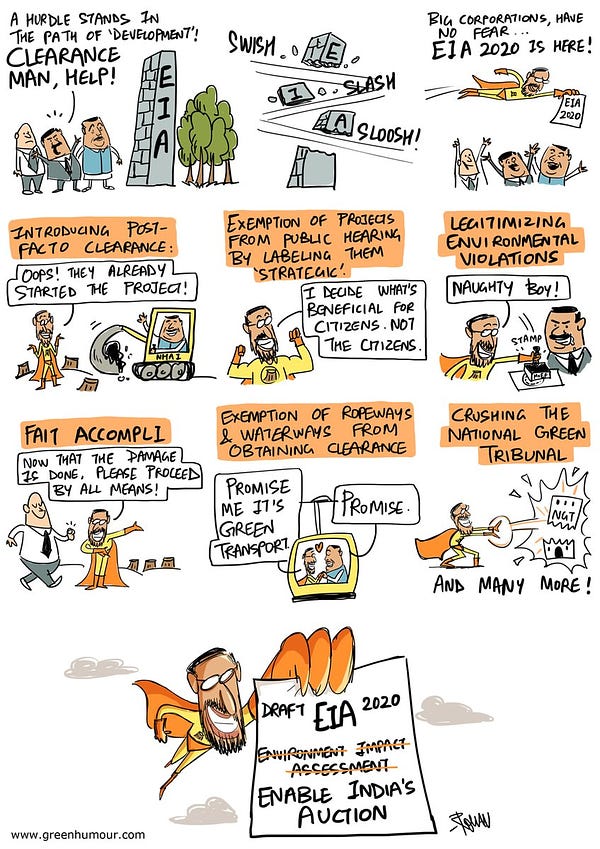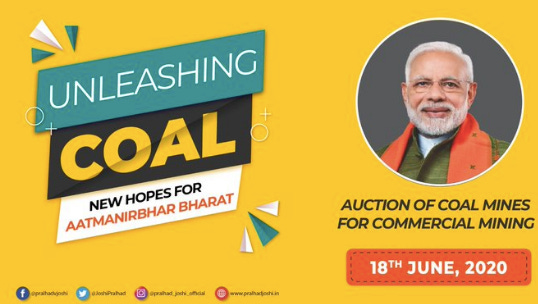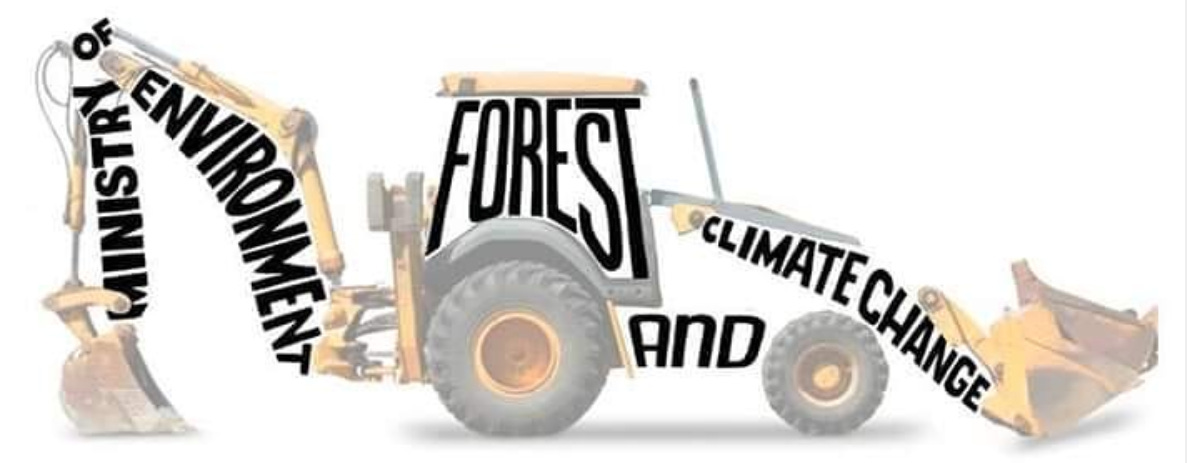In the fight against Climate Change, policy matters the most. Here's why!
India's first ever Climate Report & GOI's completely contradicting behaviour [Longread]
If your house is on fire,
will you douse the flames with water
or will you throw dry grass at it and admire?
Greenwashing, also called "green sheen", is a form of marketing spin in which green PR and green marketing are deceptively used to persuade the public that an organization's products, aims and policies are environmentally friendly.
If you want a brilliant example of greenwashing, it could be the Indian Government. I’ll tell you how, with evidence, in two acts.
Act 1 : India’s first ever climate change report
First, let me introduce to you to India’s first ever comprehensive Assessment of Climate Change over the Indian Region - A Report of the Ministry of Earth Sciences (MoES), Government of India (Link to full publication here, a brief summary here). Prepared by scientists at Indian Institute of Tropical Meteorology (IITM), Pune, the report was made public on June 16, 2020. It has all the same old dire predictions of earlier IPCC report, but it properly quantifies the impacts over Indian subcontinent for the first time ever. Extreme heat, extended monsoon with extreme flooding, extreme storms, receding glaciers, coastal inundation, water stress, more diseases and threats to food security, energy production, economic growth among others - we’ve got the whole package!
I’ll not bore you with numbers because that data, without context and a vivid imagination of the future, doesn’t mean much to the common person. Especially because all the reports talk about the year 2100 as the baseline when not one of us reading this newsletter today will be alive. But, two things stand out in the report that should be given some attention.
Even in the best case scenario, India still gets the short end of the stick compared to the majority of the world. Compared to global averages, the report predicts India will see above-average temperature anomalies. Being a diverse country with a stunning geographical range in terms of both altitude and landscape, it is only expected that we’d hit the climate crisis jackpot. But this report makes it clear that we have a tough challenge ahead not only in terms of mitigation (emissions reduction) but in adapting to the extreme impacts of climate change itself because of multiplicity of many intersecting environmental and social threats.
In a 226 page report about the environmental impacts of climate change that are described in excruciating detail, prepared by/for the government no less, only half a page is dedicated to policy recommendation. At this point, it is unequivocally established that climate change will hit us hard and that governments will need to be radical in their climate plans to avert the crisis. Yet, the government decided to not include any meaningful climate plan or policy proposal in their landmark report?
This is an independent publication funded by people like you. It takes me several days of obsessive reading, followed by research to write each newsletter issue. If you found this article useful, consider contributing any amount to my reporting fund or buy a print to support my work on climate outreach.
Listen to me talk about the importance of creative climate outreach here.
India is fifth most vulnerable to extreme weather events
According to Global Climate Risk Index 2020 report, India is already fifth most vulnerable country to climate change induced extreme weather events, recording GDP losses of upto USD 37,807 million in 2018 alone. This analysis by a German think tank quantified impacts of climate change through economic losses, losses to GDP and fatalities to arrive at a ranking among 181 countries. Clearly, climate change has a special hell reserved for India.
Regardless, should we be happy that the government has at least acknowledged climate crisis as a serious threat and give them the benefit of the doubt? And wait till the next report that will hopefully deal with the policy recommendations and implications? No can do, folks!
Here comes the ludicrous Act 2.
We know that the earth’s natural carbon cycle is over saturated and that burning fossil fuels releases more CO2 than the earth can handle, right? We also know that as of now, our best shot at naturally capturing extra CO2 in the atmosphere is preserving forests, trees that magically capture the carbon dioxide and give us food, protection and sustenance in return.
Given this information, anyone with half a brain can put two and two together and arrive at the conclusion that forests need to be protected and fossil fuels need to kept in the ground at all costs.
This is where things get interesting (or depressing to be fair). During the pandemic lockdown there have been two disturbing developments that completely disregard the findings and predictions of the climate change reports.
1. A record-breaking Environmental Clearance spree for questionable projects + seriously diluting laws that could prevent such exploitation
Our current Ministry for Environment, Forests and Climate Change(MoEF&CC), headed by Prakash Javadekar, is already infamous for prioritising ease of business over environmental protection. Ironically, he is not only our Minister for Environment, but also for Minister of Heavy Industries and Public Enterprises now. I don’t know how these diametrically conflicting portfolios coexist with a single person, but that’s not our immediate concern today.
What happened during the pandemic lockdown is what we need to be seriously worried about. Apart from fast tracking environmental clearances for projects by drastically reducing the time for clearances throughout his stint as an environment minister, Prakash Javadekar spearheaded online meetings during the lockdown to clear over 190 projects, sometimes allocating as little as 10 minutes to a project over video conferencing.
Read: Despite COVID lockdown, environment ministry’s expert panels race to clear projects
Justification? Seamless economic growth.

Link to tweet here.
Not stopping at that, he also introduced a notification to drastically dilute the Environmental Impact Assessment(EIA) laws one day before the nationwide lockdown came into effect, essentially leaving the public no way to protest against this or participate in the mandated public consultation. You should know that the earlier relatively stringent EIA laws didn’t stop the MoEF&CC from clearing projects at a record pace, but with the proposed EIA2020 it will be like having a fire sale to completely exploit our natural wealth without any severe penalty or hinderance. Like Rohan Chakravarty illustrates below, Javadekar will go down in history not as an Environment Minister but as a Clearance Man!


Following a petition by an environmentalist Vikrant Tongad, Delhi HC extended the deadline for public consultation to August 11, which was earlier randomly set at June 30th 2020.
Read: Delhi HC Extends Deadline For Public Consultation About Controversial Green Law To August 11
The court wondered what “urgency” the government felt for pushing through this notification during the coronavirus lockdown, said a person who attended the hearing.
After you educate yourself on the absolute horror of EIA2020, here are some ways to take action. Also follow @ReDraftEIA2020 on Twitter to stay updated on this specific issue and public response.
*An earlier analysis on forest clearance rates pre & post 2014 referred here has been removed because the findings are still being fine-tuned.*
Also read:
As you can see, environmental clearances went into an overdrive in the last six years and continue to pose a threat to our country’s biodiversity and people. But with the looming threat of climate change, we cannot let this slide anymore. Which brings me to the second worrying development.
2. A supremely tone-deaf commercial mining campaign called “Unleashing Coal”

Coal is the dirtiest of all fossil fuels, responsible for not only a big chunk of CO2 emissions but also for displacement of indigenous people and severe environmental degradation. Coal simply cannot be a part of any country’s economic recovery or green transition plan anymore. Yet, Narendra Modi government thought it wise to open up 41 coal blocks for commercial mining by doing away with many restrictions, to make more money.
Coal Minister Pralhad Joshi said India has one of the largest reserves of coal in the world and if it is not mined, it would turn into "mud". - Parliament passes law to open coal sector for commercial mining
It’s the age old economy vs environment all over again, but in our current reality with dire future predictions, how can we realistically allow burning more fossil fuels, much quicker and in far larger quantities? If you think I’m being too radical here, you must read my previous article that discusses how bad it is and how much time we have left to act on climate.
In what seems like a unique move, Jharkhand, Chattisgarh and Maharashtra governments are opposing this proposal stating that commercial coal mining without proper regulations in place will be detrimental to the people and the planet.
I mean, some of our elected leaders are standing up for what’s right and not for profit? I did not see this coming, but I’m very happy about it.
India is using technicalities & loopholes to inflict this environmental plunder
Greta Thunberg expertly highlighted that countries and corporates are using clever accounting to justify criminally inadequate climate targets. India is following the same playbook. India is one of very few countries worldwide that is meeting the Paris Agreement targets. And both our Prime Minister and Environment Minister consistently wax poetic about protecting environment on international platforms. But, before you celebrate this unconditionally, consider three things -
Countries themselves decide their targets (Nationally Determined Contribution) and report themselves. Independent external authorities do not checks or verify the numbers submitted. UNFCCC only provides a framework and guidelines on how to measure and submit the data.
India counts all afforestation as green cover. But afforestation is not always the same as natural forest cover. These can be commercial plantations that are planted to make money, and not intact forest ecosystems that we need to absorb our carbon emissions. So technically, India could wipe out natural forest cover and convert that area into commercial plantations, and still be meeting internationally agreed targets, purely due to “clever” accounting.
India now considers large hydropower too as renewable energy. Only in March 2019, the Indian government granted large hydropower projects the status of “renewable energy source.” Previously, only hydropower projects of less than 25 MW were considered renewable energy projects, as reported in Mongabay. Meaning, while cutting down essential carbon sinks to generate power, we can still claim to be producing green energy that is in line with the climate targets.
But is India really doing enough to curb climate crisis? Is India doing everything within its capacity?
No.
India right now is aggressively pushing for thermal and hydropower. The former is as dirty as it gets and the latter causes huge, irreversible environmental destruction. However, renewable energy production has been growing significantly in India, making for an incredible success story and is a cause for much celebration. In fact, solar energy in India right now is at the lowest per unit price ever, making it extremely affordable, much lower than coal power. This is exactly why we don’t need to cut more pristine forests to make way for damaging hydropower plants (like Etalin project) or Unleash Coal (I still can’t get over this ridiculous phrasing in the time of climate change 🙄).
If you still need convincing, read this important piece of why India refuses to let go of coal.
Coal, the fuel that powered the industrial age, has led the planet to the brink of catastrophic climate change. Soon, coal could make no financial sense for its backers. So, why is coal so hard to quit? Because coal is a powerful incumbent. - The World Needs to Quit Coal. Why Is It So Hard?
And this on the ignored costs of large hydropower projects.
As thousands of hydroelectric dams are planned worldwide, including 147 in the Amazon, a new study finds that the true socio-environmental and cultural costs of dams are rarely evaluated before construction. Were such factors counted into the lifetime cost of the dams, many would not be built. - The hidden costs of hydro: We need to reconsider world’s dam plans
Then there’s a concept in global climate negotiations called Common but Differentiated Responsibility, where the whole world agreed to work towards a common goal of emission reduction, but the responsibility will be shared based on the capacity and culpability of the country. In this setup developed countries still need to assume the majority of the emission reduction targets but developing countries are not exempt as before and will get lesser climate targets. However, not all countries are the same even in developing countries category. For instance, India and China are also technically categorised as developing countries but neither of us are incapable of meeting ambitious climate goals, in terms of technology, talent or resources, compared to let’s say small nations like Nepal or Maldives.
While I fully endorse the idea that nations like India that didn’t play a part in creating the crisis (yet) shouldn’t take the burden of sacrificing growth for the betterment of the planet overall, India really doesn’t need dirty fossil fuel to develop anymore. Whether it comes to impossible space missions or eradicating unbeatable diseases, we’ve developed a knack for succeeding with extremely limited resources purely due to ingenuity and steely determination. So I do not for once doubt India’s capability to solve our problems if we set our mind to something. But we should remember that under competent leadership we flourish and under incompetent or apathetic leadership, we flounder.
What’s the way forward?
Today, while we are making great strides towards greening our energy production, we are also on the destructive path to clearing record setting forest area and prioritising economy over environment. In our new climate reality, it is clear as day that disappearing forest ecosystems and burning fossil fuels together will be our death knell. This means our green energy plan shouldn’t include coal or huge dams. And that’s not to say solar and wind farms cannot be exploitative or harmful to the ecosystem. However, that’s the problem we should invest time and money in solving instead of blindly going after thermal and hydropower just because some technicalities allow us to do so.
Read: Renewables are cheap and effective. Now, let’s make them just and humane too
And for this to happen, our Ministry of Forests, Environment and Climate Change should be working to protect our future instead of burning(coal) and cutting down(forests) our only options to have a safe climate future.

Credit: Orijit Sen
As you can see, the fight against climate change begins at policy level. These leaders who passed the bills and gave clearances will not be in power by the end of their short terms in office. But the public will have to deal with the fallout in future and we cannot blame anyone except ourselves at that point for letting this slide today. For the commercial coal mining, let’s hope the state governments are able to pressure the centre to change their stance. For the draft Environmental Impact Assessment 2020, your voice counts. Tweet, post, email to #withdrawEIA2020!
In my opinion, Twitter is a strong platform to publicly engage with official handles and have your voice heard, because media also picks up stories from twitter trends. Tag @MoEF&CC & @PrakashJavadekar demanding accountability and withdrawal of Draft EIA2020.
But the most important thing I want you to takeaway from today’s edition is that this is how the climate fight is going to be— a long, difficult road to systemic reforms and policy changes.
Fin.
This is the third of the 52 newsletters I plan to send out in 2020 covering all things climate crisis, including original reporting, opinion pieces and explainers. This newsletter is entirely funded by public contributions. If you’d like to support my work as well, you can contribute any amount to my reporting fund, or buy a print.
If you were forwarded this email, you can learn more about me and what I do here and subscribe to my newsletter if you find it useful.
Don’t forget to hit reply or leave a public comment to tell me what you liked about this third edition, what didn’t work for you, what are looking forward to and any other suggestions? Lastly, let me know if you find any mistakes. Also do share this with your friends and family so we can all collectively kick up a storm!



